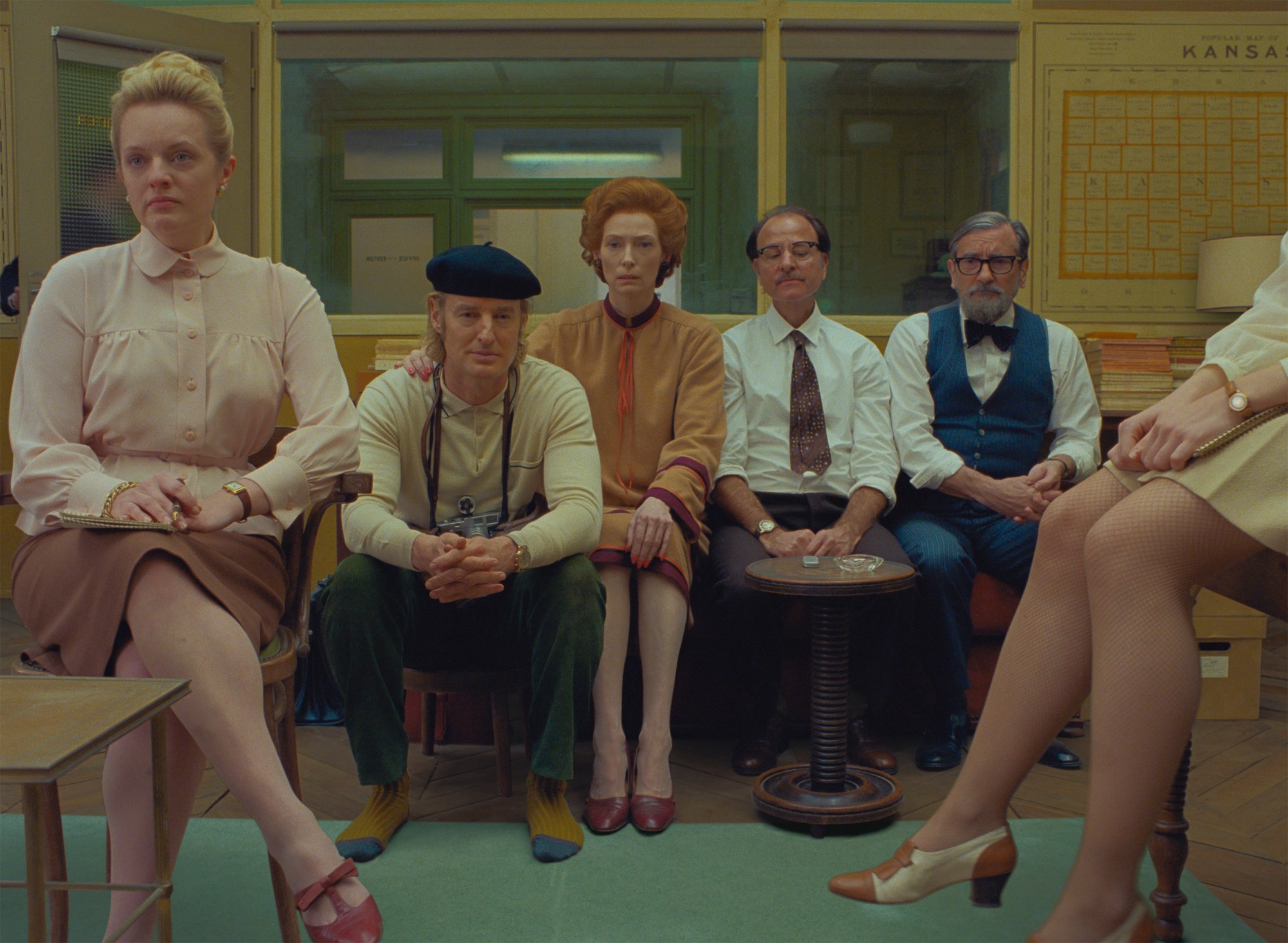There is no greater modern on-screen aesthete than Wes Anderson. The director, responsible for no fewer than 10 feature length movies (with another on the way), has managed to form a visual legacy with his films, unique in the way its chocolate box beauty doesn’t overshadow the heart of his storytelling. Whenever a new one is released — be it the almighty Moonrise Kingdom, The Grand Budapest Hotel or Isle of Dogs — there is a breaking down of the barriers between staunch arthouse cinema-goers and those who make the occasional visit. It’s expected that the trend will continue with the release of his brilliant, mad-hatter latest, The French Dispatch. So why don’t we go behind the scenes and tell you about how this sonic and visual splendour came to be?
Set in the fictional French city of Ennui-sur-Blasé, The French Dispatch tells the story of a foreign outpost of a literary magazine based out of Kansas City. In the film, we are introduced to Ennui: the rat-scattered railroads and cat-covered rooftops; the painterly sides shielding the shabbier ones. We also learn of the stories going on there: of an imprisoned artist, young revolutionaries, and a chef with talent so sublime it could help sleuthing criminals face justice. These tales play out like chapters in a book (or indeed turning the pages of a magazine), either within the city or, briefly, in the magazine’s American base. Entirely fictional — though an homage to the heyday of gorgeous literary journalism — it’s all spun from the imagination of Wes, who enlists some of the greatest creators working in cinema to bring it to life.
For the music that accompanies The French Dispatch, Wes Anderson turned to two old friends: Oscar-winning film composer Alexandre Desplat and musician Jarvis Cocker, both of whom he has worked with and known since his 2009 stop motion Roald Dahl adaptation, Fantastic Mr Fox. While Alexandre’s work, wholly original, was another take on the mix of brightness and melancholy Wes’s movies are known for, Jarvis came on board after the project had wrapped shooting, to provide an original number for the film’s 60s pop idol named Tip-Top. Instead, Wes and Jarvis agreed to record a version of “Aline” by Christophe; part of a full-length album of covers that Jarvis is releasing in tandem with the movie.
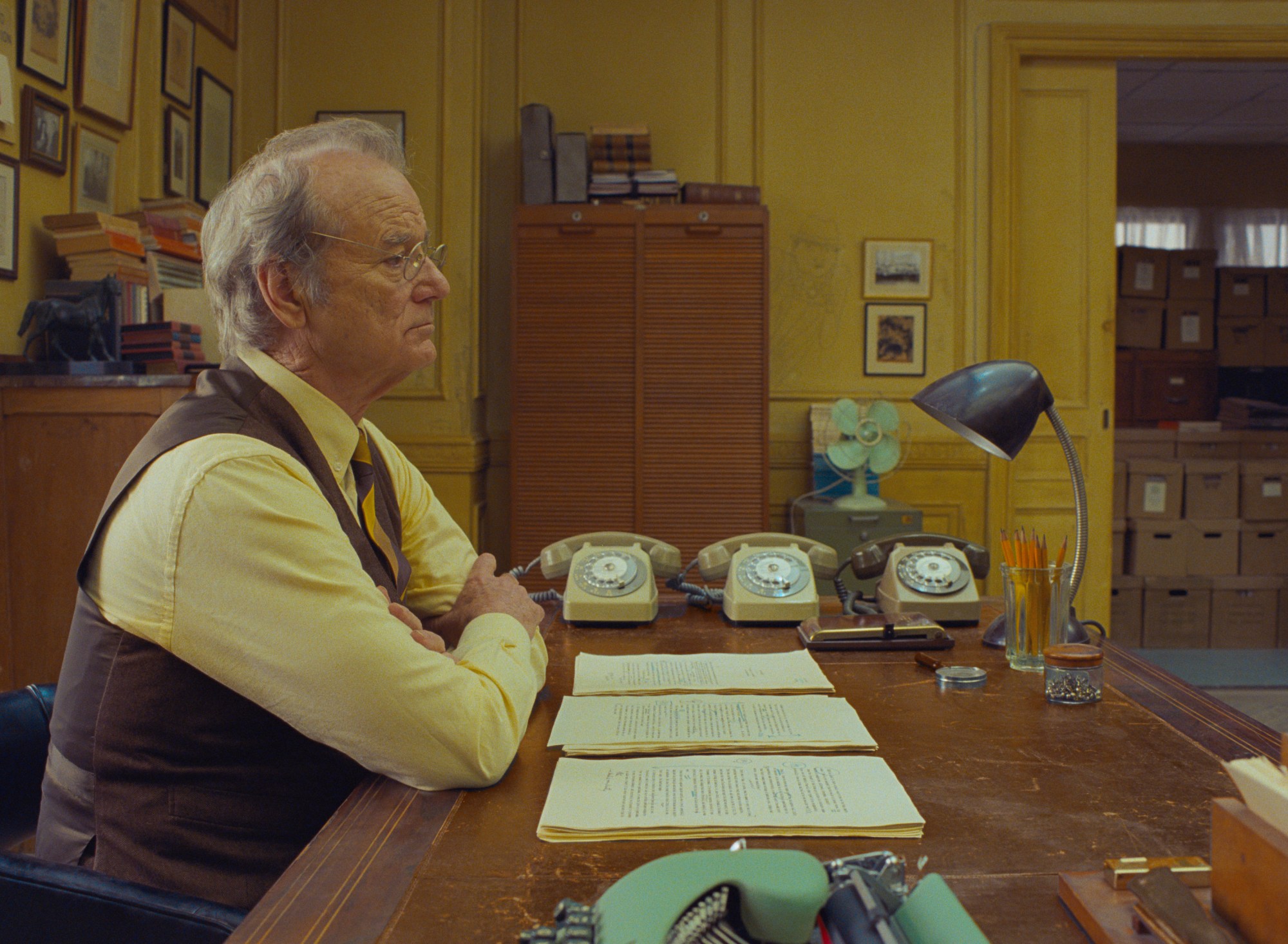
To bring the film’s visual world to life just as he imagined it, Wes called on longtime director of photography Robert D. Yeoman — who he’s worked with since his 1996 debut Bottle Rocket — to pin down its particular aesthetic. Kevin Timon Hill, the film’s art director who originally entered Wes’ circle for Isle of Dogs, is another key member of the behind-the-scenes team; as is set decorator Rena DeAngelo, who’s responsible for making sure every element of Wes’s physical world is present and perfect before the cameras start rolling.
Here, Wes, Robert, Kevin, Rena, Alexandre and Jarvis unpack the roles they played in the creation of The French Dispatch.
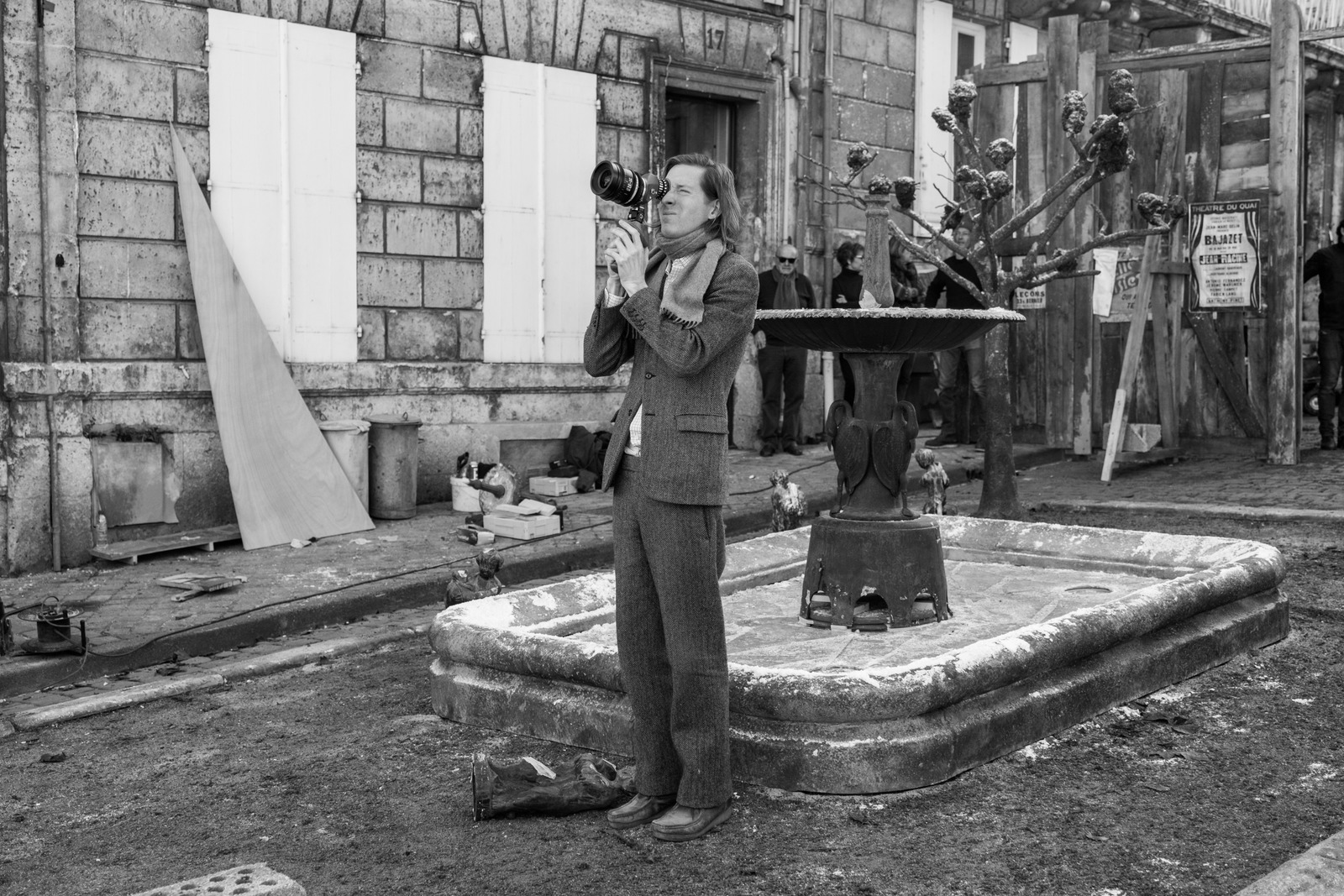
The early stages
Robert D. Yeoman (Director of Photography): Every movie with Wes is a life adventure.
Alexandre Desplat (Composer): After making many movies together, there’s a world that Wes and I are both familiar with. We know that I’m not going to go for a large, dark symphonic piece of music — even though one day we may do that — but something which is, like his films, a bit distant and gentle; poetic and jaunty. All of these elements together to make something enjoyable and fun.
Rena DeAngelo (Set Dresser): I had heard tales of the process before embarking on this project. I have known and worked with [Wes’s go-to production designer] Adam Stockhausen for years — he gave me some insights into Wes’s process, so I knew it was going to be challenging. He explained the exacting detail Wes was after: the framing, the symmetry and use of colour. Wes knew exactly what he wanted the film to look like and was able to reference a film or painting or a writer to base the character on.
Alexandre: I didn’t make it to the set for various reasons, but I remember reading the script and saying to Wes that it felt like a Dadaist movie, like none of his movies before.
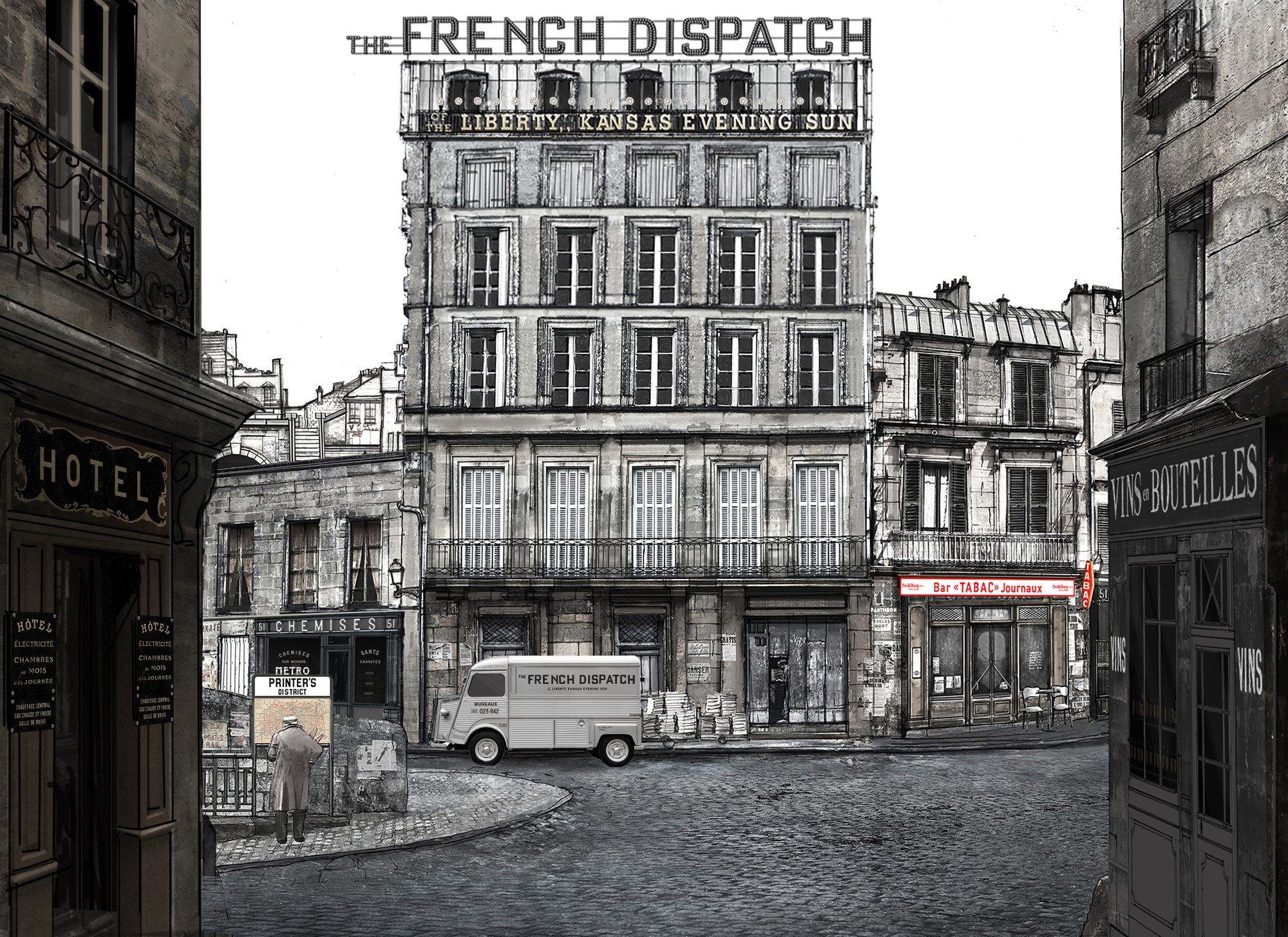
Pinning down the aesthetic
Robert: The film was shot in the picturesque city of Angoulême in France with a largely French crew, so that definitely had an effect on many aspects of our approach. We also chose to shoot much of the film on a black-and-white film stock, something I had never done before on a feature.
Kevin Timon Hill (Art Director): Wes truly does cast an eye over most things that make it on to a set long before the filming day. Nothing turns up on set that hasn’t been reviewed beforehand. There might also be a key reference, a loose rule, a banned colour or a ‘storybook feel’ that is explained that you have to keep in mind while drawing it up. I regularly review the brief when I’m working, asking myself if it captures the idea, and whether to throw it out and start over before even sending to Adam [Stockhausen] or Wes.
Rena: I thought Angoulême would be a logistical nightmare, being a five hour drive from Paris, but with the help of my local assistants, it wasn’t. The town itself was an inspiration. It had everything the script described in its architecture: winding hilly roads and staircases. It was the seedier version of Paris that Wes was looking for.
Kevin: We actually built many of the sets in the film into locations that we found in Angoulême; we incorporated the town in to it.
Wes Anderson [Director]: It’s a funny coincidence that we [premiered] the movie at the same Cannes Film Festival that opened with [Annette], a Leos Carax movie. Really, it was Leos Carax who was the inspiration for some of the scenes. You have Timothée Chalamet [who plays Zeffirelli, a teen revolutionary leader] and Lyna Khoudri [who plays young protestor Juliette] on a motorcycle together in this sequence that goes with all that, and he has these poems he’s writing. That’s all Leos Carax or Jean-Jacques Beineix. This cinéma du look period. Roman [Coppola, who co-wrote the film’s story] and I were both very conscious to bring that kind of French, teenage, poetic, rock-and-roll energy to it.
Alexandre: When I work with Wes, it’s only with Wes, so my brain goes into Wes’s world. Even when I’m asleep I’m dreaming of it.
Robert: Wes comes to the film with a very clear idea of the shots, but within that framework there is room for a certain amount of interpretation and exchange. In the end, we are all trying to make a great movie.

Making the music
Alexandre: To me, the most dadaist composer is Erik Satie, so [Wes and I] sat at the piano and decided how we might start. We started with pure piano. We tried to put together an instrumentarium that felt unpredictable; a combination of sounds that don’t make sense on paper: the harpsichord, the tuba, the bassoon, the recorders… things that are not meant to be played together. We wanted to mirror what was on screen.
Jarvis Cocker (Performer, “Aline”): The song that’s in the film, “Aline”, is one of Wes’s favourite French songs, but in fact I’d never heard it before he played it to me. And I’ve always been into French music; predominantly Serge Gainsbourg and Jacques Dutronc and stuff like that. So, as a kind of imaginative spinoff from this film, the fictional pop star Tip-Top, we did an album of songs imagining his career. But it really just gave me a chance to play these French songs I’ve been listening to for such a long time; to do a reverential version of them.
Wes: I’m sure I must’ve told Jarvis how I first heard “Aline”. I went to a party at Castel nightclub… probably around when we first met. It’s in Paris, in the Sixth [Arrondissement]. I was seated next to this small, white-haired man with a beard and blue sunglasses, and he didn’t really speak English. We sort of had a conversation, and he was very warm and nice, but we didn’t really communicate well. And at the end of the dinner, somebody said something to him, and he went over to a Yamaha-type keyboard in the corner, and he started playing this song with this thin, really high voice. Then, when he got to the chorus, the whole room erupted in unison, “Et j’ai crié, crié ‘Aline!’ pour qu’elle revienne!” It was soaring. And the rumour I heard was, oh my God, this guy is some superstar. And then I learned it was Christophe, who had sung the song originally.
After that, I bought a copy of the song, and then I used it in a Japanese TV commercial with Brad Pitt. We made two commercials, one that I thought was good, which was with “Aline”, and another one to try to satisfy all their needs. But the one with “Aline”, they discarded it completely, and they never aired it or showed it in Japan. Then the other one, they wrote me that it was their worst received commercial. Even though it starred Brad Pitt, it had the lowest rank of recognisability, of people realising it had Brad Pitt in it. They couldn’t tell it was him, which was not very good at all. But it was fine, because it meant I saved the song, and could use it for The French Dispatch.
Alexandre: We needed to work on the story, but the instrumentarium allowed us to make continuity throughout it. Even though the music changes gear, we’re always in the same sonic world. That created the continuity.
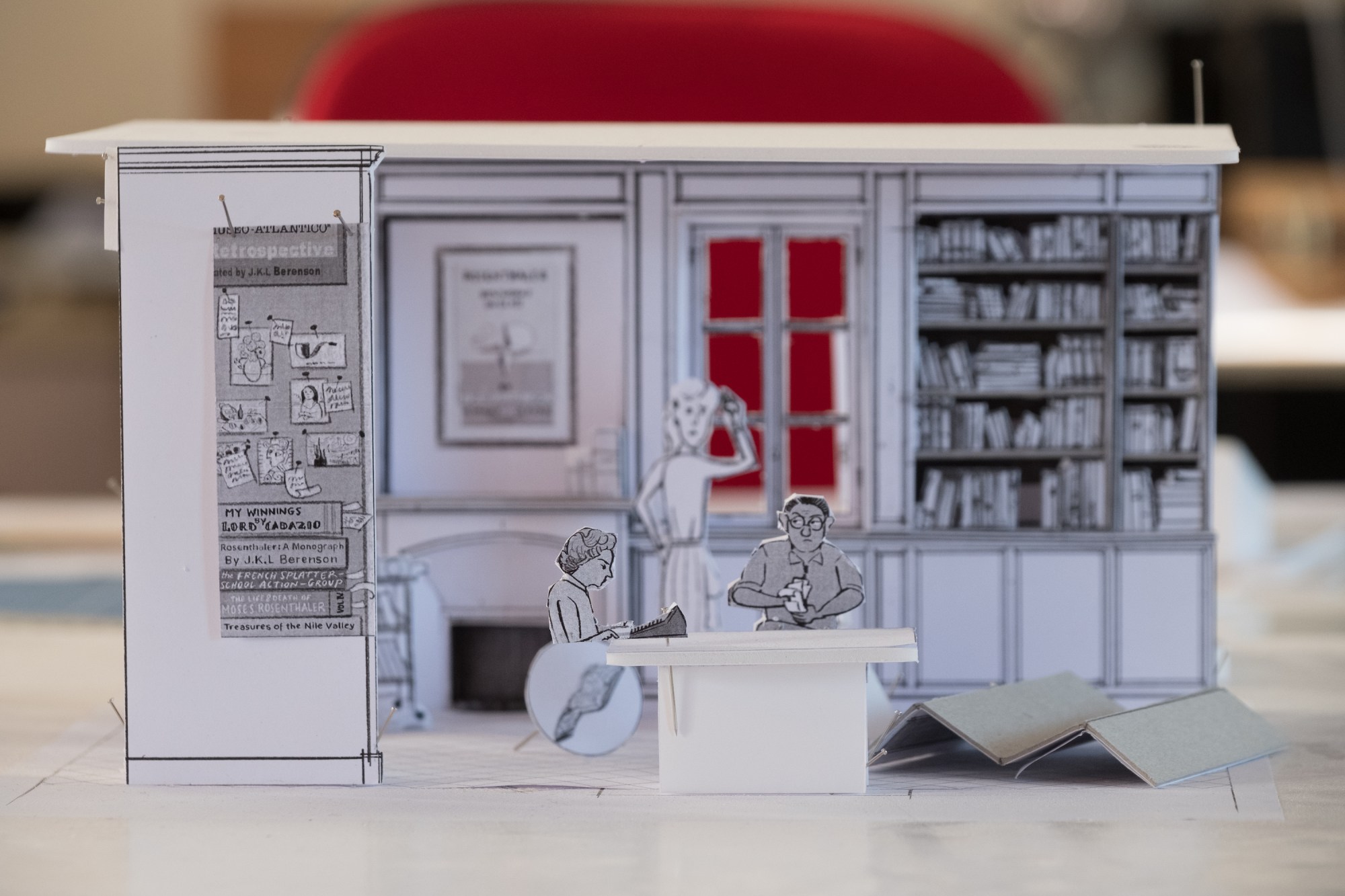
Overcoming hurdles
Alexandre: There’s never really blocks when I work with Wes. It’s flawless. I know that if I don’t have a place in mind for a piece of music, Wes will find it. He has a great imagination for that.
Kevin: [The biggest hurdle was] the long dolly shot at the start of the Roebuck Wright story, where he walks the halls and rooms of the police station. We had started to build that huge set into a location we found, but we received the storyboards just a few weeks before filming and realised that it was never going to be able to give us the heights, views and pacing that Wes needed. We had to change direction entirely. We concepted, drew and built that entire 63-metre-long set with multiple spaces from scratch in less than a month in our stage space. It was tough, but we got there.

Looking back
Robert: [The part I’m most proud of] is the bookend shots of the Le Sans Blague sequence. The camera starts outside, the walls [of the cafe] open up and we move into the room. The sequence ends with the camera inside, and the walls open again while Timothée and Lyna lean against the jukebox. It was all very tricky, with the lighting changes.
Alexandre: It’s very different [once it’s finished], of course. The opening scene of The French Dispatch, we see the neighbourhood waking up, the waiter walking up the stairs; these things are in the script but when you see it, it’s a real extravaganza. Everything falls into place like a Swiss clock. It’s like a machine that’s so beautifully organised, you’d think the music was composed at the very moment the images were filmed. It’s magical.
Rena: On the first day of shooting, to see the facade of the French Dispatch [office] in real time, with people in costume, after looking at the drawing for months was surreal. Every day, I was standing in a Wes Anderson film that I helped to create. That’s a feeling I will never forget.
Kevin: Honestly, I think design is storytelling in any practise. When you’re telling a story and you have that to keep in mind, it can make creating the aesthetic simpler; you have a kind of guide or map to the ‘right’ answer. The wonderful thing about working with Wes was having access to that road map, even if there are a few turns along the way.
Alexandre: Even though Wes speaks about something dark, be it death or fascism or struggle, the film is always going to be shown without that weight. There’s humour, there’s wit, but there’s much melancholy too. It’s all subtle, but you have to go deeper into the story. The French Dispatch starts with a death. What’s fun about that? All these things seem incidental, but with Wes these things are the core of the story. It’s the rest that’s incidental. I would call it poetic. To me, Wes is one of the rare poets of film working today.



The French Dispatch hits theatres globally on 22 October. Follow i-D on Instagram and TikTok for more on movies.
This piece is comprised of interviews and conversations conducted with members of The French Dispatch’s crew individually, that have been condensed and edited together for clarity.
